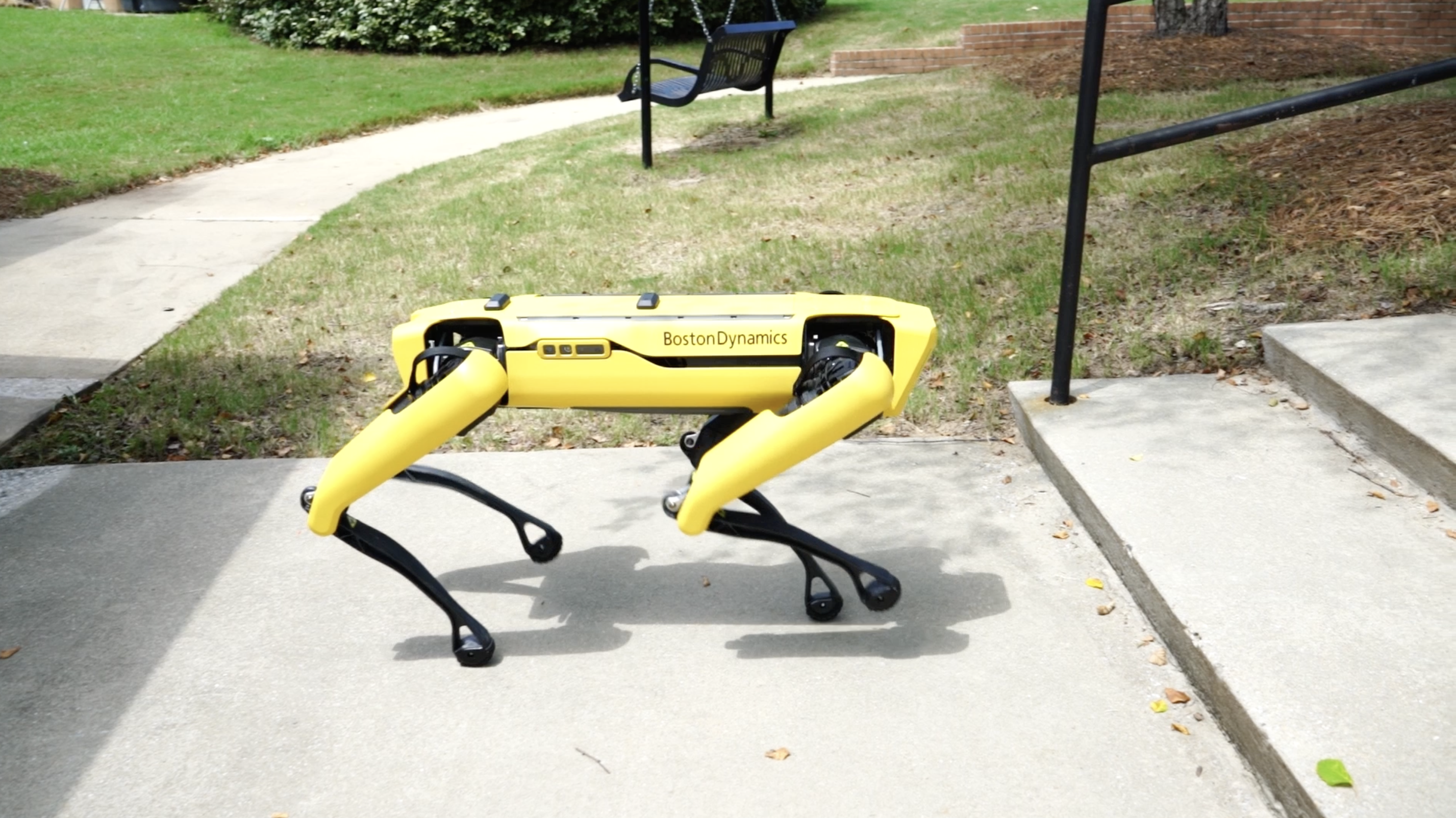Columbus State, Ft. Benning robotics partnership enhances student learning, employability
October 7, 2022

From its inception, Columbus State University’s Robotics Engineering program has benefited from strong ties with the military community—most notably with nearby Fort Benning. As the U.S. Army embraces new and expanded uses for robots, the CSU-Fort Benning partnership has grown to benefit CSU students’ experiences in the classroom and the lab, and their marketability in the workforce.
This partnership recently added a new member of the Robotics Engineering faculty, “Spot,” who is teaching Columbus State students about real-world robotics applications in the military. The quadruped robot, also known as a four-legged robot, is arguably the most important piece of technology in the military, according to Dr. Ted Maciuba, deputy director of Robotics Requirements at Fort Benning. He is also on CSU’s Robotics Advisory Board.
“Autonomy and artificial intelligence are what allows us to get an advantage over our enemies as we move into the future,” Maciuba said. “Our focus at Fort Benning is small robots for small units. What we are trying to do is to pull the Army into the information age. Our technologies are 1970s technologies (updated of course), and robotics is a key to success for those countries that have the best technology.”
Robotic applications have increased significantly since the 1970s and include a wide range of uses, from surveillance, search and rescue, combat, explosive ordnance disposal, fire-fighting and transportation. Dr. Mahmut Reyhanoglu, professor of robotics engineering and the program’s director, credited the military’s role in mainstreaming the use of robots in industry and society.
“Robots build our cars, assemble our online orders for shipping, and even vacuum our floors at home,” he explained. “Each day, we discover novel uses for these devices of all shapes and sizes, and those discoveries are increasing the demand for creative and innovative robotics engineers.”
Fort Benning faced the problem with their robots’ mobility. Since they were built with tracks or wheels and were extremely lightweight, it was difficult for them to move around obstacles like trees and rock falls—just like what soldiers deal with in the field. Fort Benning and Maciuba came to the conclusion that they needed robots that would work and move better in these types of terrains and environments.
After technologies were proposed, the quadruped seemed to be the right choice because these legged robots should be able to do what a dog can do. However, the quadruped was being teleoperated by a person, and Maciuba wants the quadrupeds to be able to understand and sense their environment and be able to move through it. He believes that CSU robotics engineering students can assist with this by putting together research proposals to try and solve the problem. CSU robotics student Sean Gillette explained that he and his classmates are trying to get a handle on how much Spot can do.
“Code-wise, we are trying to figure out where the stabilizers are in Spot and how to make it move uphill, move forward and backward,” stated Gillette. “The application of going from walking to running or speed-wise is a bigger step in trying to figure out how far we can push this type of machine.”
The partnership has allowed Gillette and his classmates access to advanced robotics equipment and broadened their access to solving real-world problems in the lab.
“It’s a very complex machine,” Gillette explained. “Right now I’ve dealt with smaller robots with fewer brains, so you can simply upload systems into it. Spot has two or three types of brains with multiple sensors attached to it, and servers running throughout it. I want to learn the internal workings of Spot so I’m on that level of machinery and robotics.”
Solving the technical workforce shortage
Both Reyhanoglu and Maciuba explained how the robotics engineering talent pool in the local region lacks qualified candidates. The broader CSU-Fort Benning partnership stands to attract and retain both military and civilian talent to the region.
According to Reyhanoglu, research collaborations like this and guidance from advisory board members like Maciuba are uniquely positioning Columbus State for military service people who wish to earn a bachelor’s or master’s degree—or both—while stationed at Fort Benning. The same holds true for service people transitioning into retirement or who have recently retired.
The Columbus State-Fort Benning partnership also includes working with regional technical colleges and high schools to spark a greater interest in STEM fields generally—and careers in robotics specifically. Their plans include a robotics development center that, through internships and hands-on experience, will improve the local talent pool for robotics.
“I’ve loved coming to CSU and talking to the robotics engineering classes because there is a level of passion there that heartens me as to the direction we have going forward,” Maciuba stated. “With the robotics engineering program, it is more likely that local high school students will stay here in Columbus, get that degree specifically in robotics engineering, and get a job here.”
Columbus State hosts Georgia’s only joint bachelor’s/master’s program in Robotics Engineering. At CSU, students prepare for careers in robotics, automation, hardware development, software development and machine learning. In addition to traditional bachelor’s and master of science degrees in robotics engineering, its accelerated Robotics Engineering program allows exceptional students to complete both a bachelor’s and master’s degrees in five years.
The university’s suite of robotics engineering offerings also includes an associate of science degree in engineering studies and a seven-course, 21-credit-hour robotics certificate program open to all CSU students and others seeking to expand their knowledge in the field.
For more information about the robotics programs at CSU, visit https://www.columbusstate.edu/letters-and-sciences/robotics/.